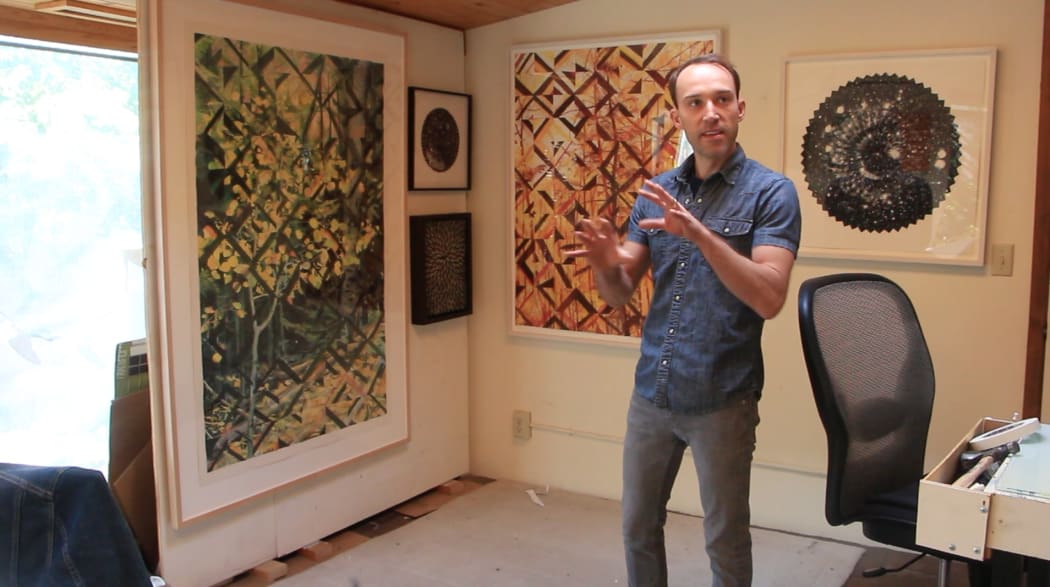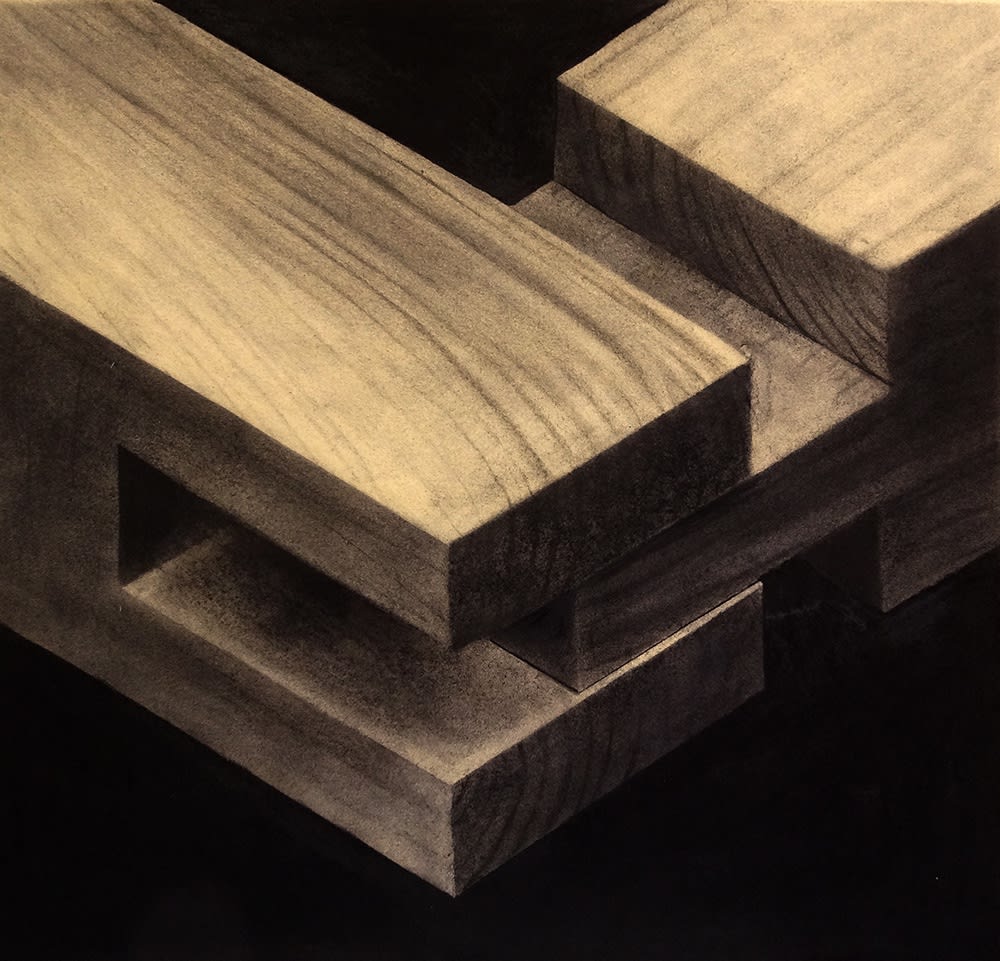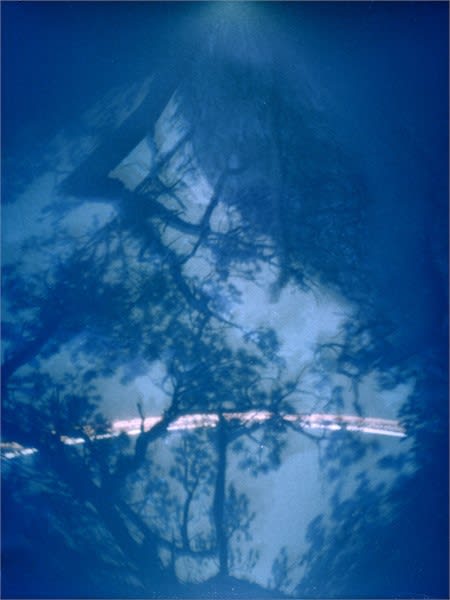
One day last year, Matthew Troy Mullins wandered into the Santa Fe Public Library while his wife, Annie, was at her final prenatal appointment. He came upon a book about wood joinery, and the elegant constructions amazed him. “I was really surprised by them,” the Santa Fe artist says. “I was looking at them almost like this visual game—this piece goes into this piece. They are static images but they have a lot of potential to imagine movement.”
Shortly after that, the family welcomed their son, Sage, into the world. Since then Mullins has been quite occupied with parenting and his job as an art teacher at Santa Fe Preparatory School, but the joinery images have stuck with him. He’s accustomed to referencing craft histories in his mixed-media paintings. In a long-running series of canvases, he combines natural imagery with geometric patterning drawn from tile and quilt designs. The wood joinery became an irresistible source of inspiration for a new series of pastel drawings.

Matthew Mullins, Rabbeted Miter Joint with Tenon, pastel & charcoal on cream paper.
“They were the first things I did after our son was born,” says Mullins. “I made one drawing with charcoal and graphite, which was a good starting point. Then I used pastel, which made the black areas darker than the charcoal I was using. The velvety surface from the pastel and the dense darkness was really attractive to me.” At the time, Mullins was making the drawings for our annual Summer Show, which has since been postponed due to the spread of COVID-19.
In the meantime, we’re presenting them here as our second studio release after last week’s feature on Thais Mather and Todd Ryan White. Read on for an interview with Mullins about his new series, the profound experience of teaching high schoolers and middle schoolers during a pandemic, and the joys of unexpected family time. As part of this release, please explore his artist page, and consider acquiring an artwork if you’re able. Mullins and form & concept will donate all proceeds from the sale of his pinhole photograph Castle Rock Canopy to the Santa Fe Food Depot.

Matthew Mullins, Dovetail Lap Joint, pastel & charcoal on cream paper.
How are you and Annie doing as new parents during a pandemic?
Annie was just saying that quarantine life doesn’t feel that different from having a newborn. She was just getting ready to return to her work as a yoga teacher when the quarantine started. She began teaching online classes from home, which have been very appreciated from her students. Strangely, we feel busier since this started. But I feel like quarantine life has been really good for family time. Since this started, our son began crawling, climbing, eating solid foods and generally getting very mobile. I feel really fortunate to be around to watch all of that really closely and to be a bigger part of his daily experience.
Is it kind of nice to have a kid who has no idea what’s going on right now?
We’re really lucky that he’s a baby, and that he’s not a four-year-old who knows about going to the park or his favorite spots on the mountain. He’s totally cool with staying close to home and not knowing what he’s missing. We’ve been going on walks and a few short runs with him.

Matthew Mullins, Rabbeted Oblique Scarf Joint, pastel & charcoal on cream paper.
How has the crisis changed your approach to teaching art at Santa Fe Prep?
I think the biggest difference is when I’m teaching at school, I go to school and I’m there all day so I can really focus on what I’m doing. Teaching from home, I might be changing a diaper 30 seconds before class starts. I’m having to switch from dad mode to teacher mode to artist mode. Things are happening all at the same time, and I have to be really nimble.
Are you still assigning homework?
No. The students are dealing with a lot right now, so I’m just trying to get art into their lives and get them to engage creatively as a way to cope or find excitement. I don’t think they will discover the richness of art if it is forced on them.

Matthew Mullins, Open Slot Mortise, pastel & charcoal on cream paper
What have your students been making?
It’s been interesting to see how different students are dealing with it. Some of the students are making really ambitious work. I think the most successful project that I’m doing with the students right now is a photographic journal of their experiences, as an attempt to make what’s going on in the world tangible. How do you make that tragedy more tangible so that you can process what’s happening? Other students are using it as a way of relaxation and escape, or to pass the time. Even though that is not as rigorous, I think that is positive too.
One of my students is doing a project where she’s making a tally mark for every single person that’s died. It’s destroying the structural integrity of the paper, so when she’s done the paper is all curled and mangled. She’s at 40,000 marks now, and it’s just staggering and mind-blowing to see these marks multiply with every class period. Some of the students have really just stepped up in ways that they probably wouldn’t have if we were in a traditional class.
Has this experience shifted your own notions of the power of art?
I think working with the students in this time period has made me think about art as artifacts, and gifts for the future. It’s about fossilizing time, crystallizing this moment, trying to keep it tangible for the future and for ourselves to make sense of things. I kind of feel like collectively we’re already trying to forget as it’s happening and that we’re ignoring the magnitude of this moment. I think it is important for artists to make art that reflects how we are in this moment and to be open to allowing the times to change us.

Matthew Mullins, Oblique Scarf Joint with Stub Tenon, pastel & charcoal on cream paper.
There’s been some recent writing about the Spanish Flu of 1918, and how it made a surprisingly small impact on culture in the years following the pandemic. Do you think that will be the case with COVID-19?
I’ve been thinking about that time in history, too. I’ve been thinking about death, and painters’ last paintings. Austrian painter Egon Schiele and his wife both got the Spanish Flu. She died, and then he died three days later. He has a series of drawings where it was clear that she was dying, and that they might both die. They’re incredible, really heartfelt and urgent drawings. One was made while on their deathbed. I’m trying to think, if I knew I only had a few more weeks or a month, what would I make? If that were the case, would I make all of the paintings that I was making when this first started? I don’t know, maybe not.
I was really into a lot of the paintings I was working on in my studio two months ago, but now I’m having trouble digging into them and they are feeling like they are from another time. I hope this time leaves a deep cultural imprint and teaches us lessons about empathy and sustainability. We’ve been going so fast. I hope things slow down and that more space for introspection opens up.
It sounds like you’re experiencing a major creative shift!
I think so. I hope so.
I’ve started making a lot of autobiographical work. I’m making a really big drawing of Annie breastfeeding Sage. I wouldn’t have been made that a few weeks ago, but this feels like what I should be making now. We did a photoshoot for it the other day, and it was thrilling. I can’t wait to get started. Right now I’m just trimming the paper and working with my source photo and getting things ready. I’m also doing some other figurative stuff, more things with my own body. I’ve been doing some drawings and watercolor paintings of my hands.
I’m not traveling in the same way that I was when I was shooting lots of landscape photography to use for my paintings. I’ve kind of exhausted my digital archive and I no longer go to Kinkos for prints, so I’ve been working from silver gelatin photos that I print in the school’s darkroom. That’s been changing things a lot as well.
How so?
There’s more subtlety, and I’m able to focus more attention on midtones and gradations of light and finer detail. The silver grain is a much richer surface to work from than a digital photo. I’m getting really into working with film.

Matthew Mullins, Pegged Mortise and Tenon, pastel & charcoal on cream paper.
Speaking of rich detail, how did the wood joinery pastels come about?
That idea really surprised me. It kind of came out of nowhere. We were downtown and I walked over to the library and found this book on wood joinery. I was stunned by the images and surprised where they took my imagination. I was looking at them almost like this visual game, this piece goes into this piece and that piece goes into that piece. They are very satisfying visual puzzles that we complete in our minds. All of the images unfolded for me in a really fun, playful way. They’re kind of sexual and mysteriously funny to me.
I’m really excited about these, so I need to pay attention to that and see where it goes. I made one drawing with charcoal and graphite. Then I used pastel, and that got even darker than the charcoal I was using. The velvety surface from the pastel and the dense darkness was really attractive to me.
Did you draw a conscious connection from your past works, which reference craft, and this new subject of wood joinery?
It was definitely more of an instinctual thing and more from curiosity. I had to tug on this little thread to see what happened. Once I started drawing them and getting them on paper, I started appreciating how the two pieces of wood created architectural compositions. They began to feel like what would happen if a Sol Lewitt drawing and a Morandi painting had a baby. It broke up the paper in this really architectural way, and I really liked that. There was this play of flat space asserting itself, and then another element of three-dimensional space.
When you look at them, the negative space in between the wood forms an “i” shape. That dark form comes out at you. I like that interplay between flattening and space, which relates to what I was getting at with the pattern and landscape paintings. The pattern flattens it out and the landscape creates this depth. When I started, I was like, “this is going to have zero connection to anything else.” Then I was like, no, actually, I see where this is coming from.

Matthew Mullins, Castle Rock Canopy, archival pigment print.
If Castle Rock Canopy sells, you’re teaming up with form & concept to donate all proceeds to the Santa Fe Food Depot. What inspired that?
Hunger and food insecurity were such a big problem in Northern New Mexico before this happened. The virus is making this situation much worse. It’s a particularly urgent and important time to help out. Before the Stay At Home Order, a group of Santa Fe Prep eighth graders and I volunteered at the Food Depot every Thursday through Prep’s Teen Action Program. It’s been great seeing the amazing work that they do, in person. Donating the proceeds of a sale seemed like a good opportunity to help out an organization that does so much for our community.
Visit Matthew Mullins' artist page.